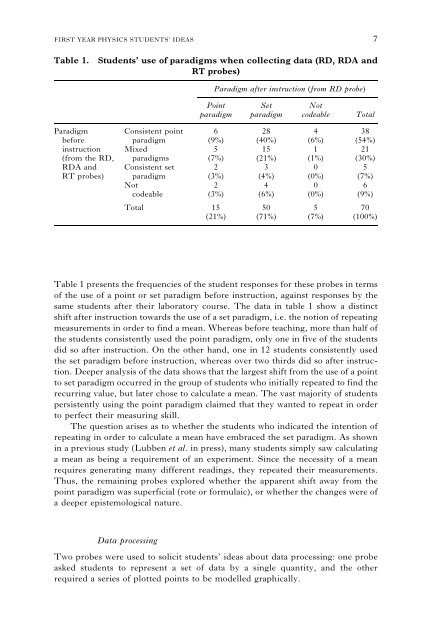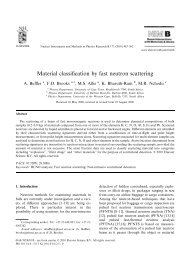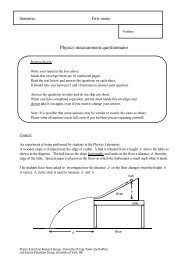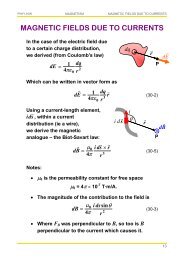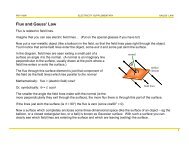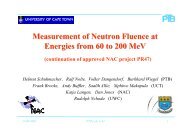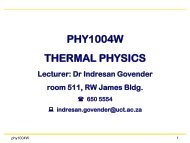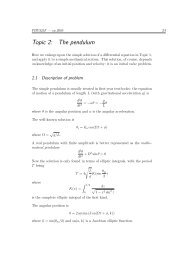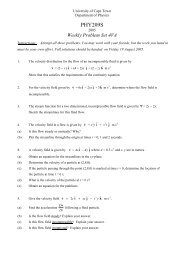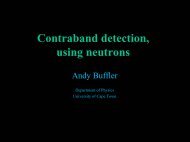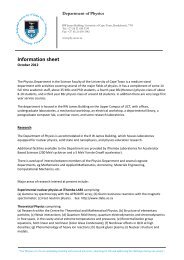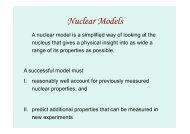ideas about measurement in terms of point and set paradigms
ideas about measurement in terms of point and set paradigms
ideas about measurement in terms of point and set paradigms
You also want an ePaper? Increase the reach of your titles
YUMPU automatically turns print PDFs into web optimized ePapers that Google loves.
FIRST YEAR PHYSICS STUDENTS’ IDEAS 7<br />
Table 1.<br />
Students’ use <strong>of</strong> <strong>paradigms</strong> when collect<strong>in</strong>g data (RD, RDA <strong>and</strong><br />
RT probes)<br />
Paradigm after <strong>in</strong>struction (from RD probe)<br />
Po<strong>in</strong>t Set Not<br />
paradigm paradigm codeable Total<br />
Paradigm Consistent po<strong>in</strong>t 6 28 4 38<br />
before paradigm (9%) (40%) (6%) (54%)<br />
<strong>in</strong>struction Mixed 5 15 1 21<br />
(from the RD, <strong>paradigms</strong> (7%) (21%) (1%) (30%)<br />
RDA <strong>and</strong> Consistent <strong>set</strong> 2 3 0 5<br />
RT probes) paradigm (3%) (4%) (0%) (7%)<br />
Not 2 4 0 6<br />
codeable (3%) (6%) (0%) (9%)<br />
Total 15 50 5 70<br />
(21%) (71%) (7%) (100%)<br />
Table 1 presents the frequencies <strong>of</strong> the student responses for these probes <strong>in</strong> <strong>terms</strong><br />
<strong>of</strong> the use <strong>of</strong> a po<strong>in</strong>t or <strong>set</strong> paradigm before <strong>in</strong>struction, aga<strong>in</strong>st responses by the<br />
same students after their laboratory course. The data <strong>in</strong> table 1 show a dist<strong>in</strong>ct<br />
shift after <strong>in</strong>struction towards the use <strong>of</strong> a <strong>set</strong> paradigm, i.e. the notion <strong>of</strong> repeat<strong>in</strong>g<br />
<strong>measurement</strong>s <strong>in</strong> order to f<strong>in</strong>d a mean. Whereas before teach<strong>in</strong>g, more than half <strong>of</strong><br />
the students consistently used the po<strong>in</strong>t paradigm, only one <strong>in</strong> five <strong>of</strong> the students<br />
did so after <strong>in</strong>struction. On the other h<strong>and</strong>, one <strong>in</strong> 12 students consistently used<br />
the <strong>set</strong> paradigm before <strong>in</strong>struction, whereas over two thirds did so after <strong>in</strong>struction.<br />
Deeper analysis <strong>of</strong> the data shows that the largest shift from the use <strong>of</strong> a po<strong>in</strong>t<br />
to <strong>set</strong> paradigm occurred <strong>in</strong> the group <strong>of</strong> students who <strong>in</strong>itially repeated to f<strong>in</strong>d the<br />
recurr<strong>in</strong>g value, but later chose to calculate a mean. The vast majority <strong>of</strong> students<br />
persistently us<strong>in</strong>g the po<strong>in</strong>t paradigm claimed that they wanted to repeat <strong>in</strong> order<br />
to perfect their measur<strong>in</strong>g skill.<br />
The question arises as to whether the students who <strong>in</strong>dicated the <strong>in</strong>tention <strong>of</strong><br />
repeat<strong>in</strong>g <strong>in</strong> order to calculate a mean have embraced the <strong>set</strong> paradigm. As shown<br />
<strong>in</strong> a previous study (Lubben et al. <strong>in</strong> press), many students simply saw calculat<strong>in</strong>g<br />
a mean as be<strong>in</strong>g a requirement <strong>of</strong> an experiment. S<strong>in</strong>ce the necessity <strong>of</strong> a mean<br />
requires generat<strong>in</strong>g many different read<strong>in</strong>gs, they repeated their <strong>measurement</strong>s.<br />
Thus, the rema<strong>in</strong><strong>in</strong>g probes explored whether the apparent shift away from the<br />
po<strong>in</strong>t paradigm was superficial (rote or formulaic), or whether the changes were <strong>of</strong><br />
a deeper epistemological nature.<br />
Data process<strong>in</strong>g<br />
Two probes were used to solicit students’ <strong>ideas</strong> <strong>about</strong> data process<strong>in</strong>g: one probe<br />
asked students to represent a <strong>set</strong> <strong>of</strong> data by a s<strong>in</strong>gle quantity, <strong>and</strong> the other<br />
required a series <strong>of</strong> plotted po<strong>in</strong>ts to be modelled graphically.


